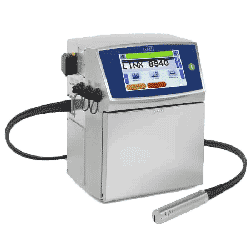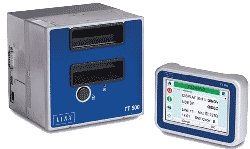Coding and Marking on Flexible Packaging

Flexible packaging has become increasingly popular in the packaging industry due to its convenience and versatility. Thermal inkjet printing specializes in coding and marking on flexible packaging. This process involves using heat to create small gas bubbles, which further eject ink droplets onto the packaging material. Furthermore, digital date coding on the packaging is also an excellent option for manufacturers as it ensures accuracy and reliability. With the advent of advanced technologies, coding on flexible films has become more smooth and efficient. Whether for inventory or tracking the packaging product, these inkjet date coder results as the best.
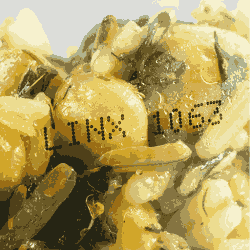
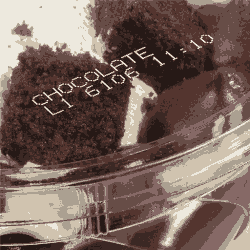
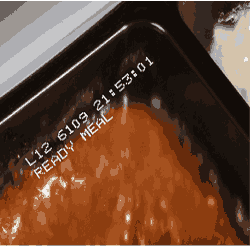
Inkjet Coding on Film and Shrink Wrap
Printing and coding on flexible packaging have never been easier with the Linx printing technology. The Linx printer can quickly code and mark onto a wide range of substrates with various ink and fluids. Coding on hard plastics, films/bags, packaging, or shrinkwrap explicitly. The coders can provide clear and error-free codes, ensuring customer satisfaction. Linx offers a range of printers, including continuous inkjet printers, thermal transfer over printers, and laser coders to cater to different printing and coding needs. To top it up, Linx also provides options for high-contrast pigmented inks and special adhesive inks in its industrial inkjet range to cater to specific customer requirements, making it the go-to solution for printing and coding on flexible packaging.

Thermal Transfer Printers for Flexible Packaging
Flexible packaging presents unique printing and coding challenges, particularly for food manufacturers requiring traceability and regulatory compliance. Materials used for flexible packagings, such as paper, plastic, foil, and film, have different absorbs. And require specific types of printing, labeling, and coding machinery. In addition to the food industry, various industries, including health & beauty, cleaning supplies, and beverages, use flexible packaging. Manufacturers should verify regulatory requirements for their specific industry to ensure complete traceability and compliance.
Related Products
Frequently Asked Questions
Inkjet Coding and Marking Solutions
A continuous inkjet (CIJ) coding printer (non-contact printing technology) can quickly print high-quality codes, text, and graphics on various substrates. Food, beverage, pharmaceuticals, and packaging industries mostly use CIJ for marking batch numbers, expiry dates, and barcodes. Here’s an overview of how a CIJ coder works:
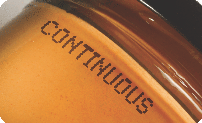

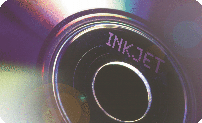

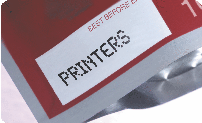

Continuous Inkjet Printer Workings
- Ink System:
The Continuous Inkjet printer has an ink system so that it can reserve ink. The ink, which typically contains solvents, dyes, or pigments, circulates continuously through the system. - Ink Pressure and Circulation:
CIJ pressurizes the ink and pumps it from the reservoir to the printhead. After passing through the printhead, CIJ collects the unused ink and returns it to the reservoir for recirculation. - Printhead and Nozzle:
The printhead contains a nozzle with a small opening, usually ranging from 40 to 70 microns in diameter. A piezoelectric crystal inside the nozzle vibrates at a specific frequency, typically between 60,000 and 120,000 times per second. - Droplet Formation:
As the pressurized ink enters the vibrating nozzle, it breaks into individual droplets due to the vibration effect. These CIJ droplets release in a continuous stream from the nozzle. - Charge Electrode:
Immediately after the droplets exit the nozzle, they pass through a charged electrode. The electrode imparts an electrostatic charge to each droplet, depending on the intended position of the printable character. - Deflection Plates:
The charged ink droplets travel through a pair of deflection plates, which create an electric field. Depending on the droplet charge with a more or less electric field, determining their position on the substrate. - Printing on the Substrate:
The accurately deflected CIJ droplets reach the substrate, creating the desired characters or graphics. Meanwhile, the non-deflected droplets fall into a gutter and return to the ink reservoir for recirculation. - Drying and Curing:
As the ink droplets land on the substrate, the solvents evaporate quickly, leaving behind the ink on the surface. This process results in a high-quality, permanent print that is resistant to smudging and fading.
Print with Food Grade Inks
The Continuous inkjet coder’s ability to print directly on moving products makes it an ideal choice for many industrial coding applications. Additionally, the technology offers high-speed printing, low maintenance requirements, and the capability to produce high-resolution prints with minimal downtime.
Expiry Date Printer
Continuous Inkjet Printers are popular for printing variable information, such as dates or batch codes during production. These printers explicitly handle products of different sizes, shapes, or textures, making them prime for many industries. Furthermore, Linx Printing Technologies offer a range of continuous inkjet printers that are cost-effective and efficient. Some features include remote printer monitoring and customer support, concealed and easy-to-clean printheads, error-free touch-screen control, and simple self-service capability. Compared to other industrial inkjet coders, Linx’s printers provide a reliable and quality solution to meet your needs.






Linx 8900 Continuous Inkjet Printer (CIJ)
This printer delivers efficient output with the help of a remote application to keep you in control anytime and anywhere. Moreover, Linx CIJ allows you to print up to six lines, including barcodes, batch coding, and QR codes. Therefore it’s perfect for high-speed production, retail packaging, and 24/7 operations.
Linx 8900 inkjet coder has popularity because of its remote access, control, and support through the Linx PrinterNet. This allows for error-free coding by enhancing your monitoring and control capabilities. Additionally, it features a quick operation with a touchscreen interface, self-service, and minimal intervention to maximize production uptime. The Linx 8900 CIJ Printer allows you to print onto both primary and secondary packaging. Hence, one printer further makes your printing process easy.
Take your production to the next level with the Linx 8900 Continuous Inkjet Printer.






Printing expiry dates on flexible packaging is essential for ensuring product safety, compliance, and traceability. Several methods are available for printing expiry dates on flexible packaging, each with advantages and limitations. Here are some popular options:
- Continuous Inkjet (CIJ) Printer:
CIJ printers are widely used for printing expiry dates on flexible packaging because they can print directly on moving products on a production line. They offer high-quality, durable prints and can handle a variety of substrates, including flexible films and pouches. Choose an ink specifically designed for flexible packaging materials to ensure proper adhesion and durability. - Thermal Inkjet (TIJ) Printers:
TIJ printers use heat to eject ink droplets from nozzles onto the flexible packaging surface. They produce high-resolution prints and are suitable for applications requiring fine details or smaller text. TIJ printers work well for printing expiry dates on various flexible packaging materials, such as plastic films and laminates. Select an ink that is compatible with the specific flexible packaging material for optimal results. - Thermal Transfer Over Printer (TTO):
TTO printers use heat and pressure to transfer ink from a ribbon onto the flexible packaging surface. This method provides high-quality, durable prints and is particularly suitable for printing on thin films and labels used in flexible packaging. TTO printers offer excellent print resolution and can produce sharp, clear text, barcodes, and graphics.
Print Expiry Date on Packaging Films


When selecting a method for printing expiry dates on flexible packaging, consider factors such as the packaging material, production speed, required print quality and durability, and the complexity of the design. Each method has advantages and limitations, so choose the one that best fits your needs and requirements.
To ensure successful expiry date coding and marking on flexible packaging, follow these best practices:
- Choose the appropriate printer and ink/ribbon based on your packaging material and application requirements.
- Regularly maintain and clean the printer to ensure consistent print quality and prevent downtime.
- Test the adhesion, readability, and durability of the printed expiry date on the flexible packaging material before full-scale production.
- Implement a quality control system to monitor and verify the accuracy of the printed expiry dates throughout the production process.
In general, the Linx inks can print with ease on flexible packaging with an inkjet coding machine. Variety of inks and fluids depending on the material and application requirements. Here are some popular ink types:


- Solvent-based Inks:
CIJ printers and some TIJ printers commonly use solvent-based inks. These inks contain pigments or dyes dissolved in a solvent that evaporates quickly. Indeed, leaving behind durable and high-quality inkjet printing on flexible packaging materials. Solvent-based inks offer good adhesion, quick drying times, and resistance to chemicals and abrasion. - Water-based Inks:
Water-based inks are suitable for use with some TIJ printers and flexographic printing systems. These inks contain pigments or dyes suspended in a water-based solution, making them more environmentally friendly than solvent-based inks. Water-based inks work well on porous substrates, such as paper and uncoated flexible inkjet packaging materials. But may not adhere well to non-porous materials without surface treatment. - UV-curable Inks:
UV-LED inkjet printers use UV-curable inks and offer excellent adhesion, durability, and resistance to chemicals and abrasion. These inks contain photoinitiators that cure instantly when exposed to UV light. Additionally, creating high-quality inkjet coding on various flexible packaging materials, including plastic films and laminates. - Hot-melt Inks:
Thermal transfer over printers (TTO) uses hot-melt inks, also known as solid inks. Also, some drop-on-demand (DOD) inkjet printers use hot melt inks. These inks come in solid form, and the print head melts the ink during the printing. As a result, transferring it from a ribbon onto the flexible packaging material. Hot-melt inks offer good adhesion and durability, making them suitable for printing on thin films and labels.
Buy the best inkjet coder for packaging.
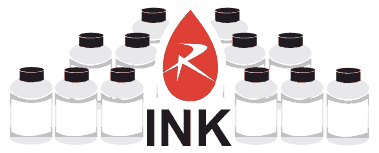

When selecting the best ink for inkjet coder for printing flexible packaging printing, consider factors such as the printer type, packaging material, production speed, required print quality and durability, and environmental considerations. Each ink type has advantages and limitations, so choose the one that best fits your coding and marking requirements.
Continuous Ink Jet Printer


Continuous Ink Jet Printer (CIJ) – High-speed, non-contact printing technology in time. Industries prefer these printers for coding and marking product and packaging information. It prints product data likewise, batch numbers, expiry dates, barcodes, QR codes, and logos on a wide range of materials.
Linx Global is a leading manufacturer of inkjet coding solutions and ink-jet printers. These printers are known for their ease of use and their need for very low maintenance. Linx CIJ best fits businesses looking to improve their coding and marking quality.
Benefits of Linx Global CIJ Printers in detail:






InkJet Coder for Printing Expiry Dates


- High-speed printing:
Linx continuous ink-jet printers can print easily despite fast-moving production lines and ensure minimal downtime. - Non-contact printing:
The CIJ technology allows non-contact printing with the substrate in detail. Indeed it enables coding on uneven surfaces and reduces the risk of damage. - Wide range of inks:
Linx offers a variety of ink types, such as food grade, pigmented, and special inks. - Easy setup and operation:
Continuous ink-jet printers feature provides not only user friendly access but also a quick change of ink systems. As a result, this makes them easy to set up, operate, and maintain. - Robust design:
Linx continuous inkjet printers can print in harsh environments coupled with sealed print heads to protect against dust and moisture. - Low maintenance:
CIJ printers require minimal maintenance with self cleaning print heads in effect. Also, it provides automatic diagnostics, ensuring optimum performance and reduced downtime. - Connectivity and integration:
Above all, These printers offer various connectivity options and can be easily integrated with existing production lines.
Overall, Investing in a Linx Global Continuous Ink-jet Printer can achieve clear coding and marking directly on your product.



